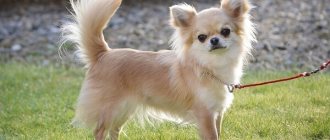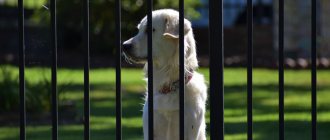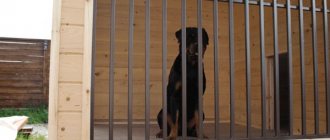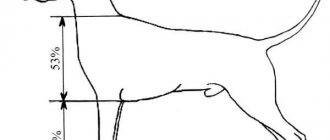The Labrador and the Golden Retriever have earned worldwide fame. They became famous as wonderful nannies, companions and service dogs. They are often kept as family dogs. However, before choosing a puppy, you need to understand which breed is closer in spirit. Labrador and retriever: what is the difference, let's look at it in more detail.
Labrador
The history of the breed dates back to the 19th century. It is believed that the ancestors of modern Labradors were the so-called “little Newfoundlands.”
It was these dogs that were brought to Great Britain, where, as a result of their crossing with curly-coated retrievers and, probably, English foxhounds and setters, Labradors were bred.
Description
Labradors are well-built dogs with regular proportions, a large head, a broad chest and powerful limbs.
Despite the good-natured and attentive look of representatives of this breed, their restrained strength and willingness to act cannot go unnoticed.
The average life expectancy of Labradors with proper care and suitable living conditions is 12-14 years.
Adults grow to 54-57 cm at the withers and weigh 27-40 kg.
The breed standard
allows for minor deviations in growth.
Exterior
Description of the exterior in accordance with the FCI system :
- the body is slightly stretched, the back line is straight, the lower back is strong and wide;
- chest of moderate depth, rounded ribs;
- the skull is moderately wide, there are no rough lines, the transition from the forehead to the non-pointed muzzle is clearly defined;
- jaws are well developed, scissor bite;
- the limbs are straight, the shoulders are long and oblique, the paws are arched;
- eyes are medium-sized, hazel or brown;
- ears are hanging, medium size, set far apart;
- the undercoat is waterproof, well developed;
- The outer hair is dense and coarse, without waves or fringes.
The coat color can be deep brown, light or black.
For dogs of fawn and chocolate color, brown pigmentation of the nose is allowed .
Character
Labradors are good-natured and playful dogs. Their optimism and cheerful attitude help create an atmosphere of happiness, calm and harmony in the family.
Almost constantly being in a good mood, Labradors are not characterized by despondency and passivity . These are active dogs that enjoy playing with their owner or on their own.
At the same time, they absolutely cannot stand loneliness and need constant communication and attention.
Labradors are smart and quick-witted animals that are easy to educate and train. Moreover, they themselves love it when their owner works with them and try with all their might to please him, accurately following all commands.
Medical and acting activities
Among all dog breeds, these two have gained fame as rescuers, doctors and actors. They are excellent guides and are indispensable in the field of canistherapy. Treatment is especially good for children with physical and psychological developmental disabilities. And yet, Labradors are preferable as healers. The main trump card of retrievers is playing as film actors, where they are unsurpassed specialists.
In conclusion, I would like to say that both breeds will be your faithful friend in all your endeavors, as well as an excellent companion for your children .
Golden retriever
For a long time, it was believed that golden retrievers owe their appearance to the Scottish Lord Tweedmouth, who claimed that Russian shepherd dogs he acquired at one of the circus performances in 1858 were used in breeding the breed.
However, in the 20th century. it became known that Tweedmouth bought a golden puppy and crossed it with a spaniel, resulting in golden puppies .
Bloodhounds, black retrievers and Irish setters were also used to develop the breed.
Description
Strong bones, harmonious and symmetrical physique, confident movements and an attentive, friendly look - this is what catches your eye when you see golden retrievers.
Representatives of this breed live on average 10-12 years.
The height of adult individuals at the withers is 51-61 cm, and weight is 25-41 kg.
The breed standard does not have clear regulations regarding the body weight of Golden Retrievers.
Exterior
Breed standard:
- the head is proportional to the body;
- the skull is slightly convex, wide, with a clear transition from the forehead to the muzzle;
- the muzzle is straight and long;
- ears are rounded at the ends, hanging, set at eye level;
- jaws are strong, scissor bite;
- dark brown eyes with the same rim;
- neck with developed muscles, medium in length;
- the legs are powerful, muscular, the length of the shoulder blades is equal to the length of the shoulders, the elbows are adjacent to the body, the shoulder blades are laid back;
- The coat is straight, smooth or wavy, the undercoat is dense.
The standard allows any coat color, except dark red and mahogany.
Character
Golden retrievers are not known for their aggressive behavior. They are friendly to everyone without exception, adore their owners and strive to spend as much time as possible with them. These dogs are extremely difficult to tolerate separation and loneliness.
CAREFULLY!
If the dog is required to perform guard and security functions, then golden retrievers are not the best choice.
Representatives of this breed will notify about the appearance of strangers with a loud bark, but at the same time they will prefer to make friends with them than to defend their owners.
Goldens are distinguished by a high level of energy and a love of active, active games. They love water and enjoy participating in water activities, satisfying their hunting instincts.
Due to their high intelligence, retrievers can be trained without problems . Today, these dogs are often used as guide dogs or therapy dogs.
One country - two stories
The FCI standard classifies the Golden Retriever and the Labrador Retriever as a single variety: Group 8 (Retrievers), Class 1. But these are two different breeds.
In total, there are 6 representatives in the group of retrievers: Chesapeake Bay, straight-haired, curly-haired, Nova Scotia, Labrador and golden. The last two are most similar to each other.
Choosing a breed is impossible without understanding that the dogs were bred as gundogs and companion dogs. However, the goal was different.
They appeared in Great Britain, but in different kingdoms. Labradors were brought to England by fishermen from the island of Newfoundland. It is believed that the dogs originated from a local breed group and are closely related to the Diver breed. Previously, they were called small St. John's dogs, while Newfoundlands were called large dogs.
They not only brought shot game, but also took fish out of snares, pulled nets and sleds.
The Golden Retriever initially had one goal - to retrieve a killed or wounded bird. They were brought out by the Scottish Lord Tweedmouth. He spent half his life trying to get representatives with the perfect golden color that stands out against the peat background.
As a result, Labradors are simple-minded, tireless workers. Their name is translated from Portuguese as “toiler”, “hard worker”. And goldens “inherited” aristocracy, calmness and restraint from their forefather.
Golden retriever puppy
Today, retrievers are rarely used for hunting. They have “retrained” as service dogs. These are the best guides, caregivers, and rescuers. Dogs also “work” at customs and in the police.
A Labrador's sense of smell is 25% sharper than a Shepherd's. This quality is used to detect drugs.
What are the differences?
There are several major differences between Labradors and Golden Retrievers related to their appearance and personality.
Coat type and what they look like in the photo
The coat of Labradors is covered with a specific waxy coating, characteristic of frequently swimming dogs. The guard coat is thick, elastic and dense, without curling or waviness.
Golden retrievers have a more decorative coat: it is shiny and slightly wavy . Beautiful feathering is clearly visible on the tail, neck, hips, and back of the forelimbs.
Body type
Labradors have a dense, muscular body and strong bones . They have a wide chest and back and a short loin, ears are slightly shorter and set higher, the head is larger, and the muzzle is less elongated.
The physique of goldens is more graceful. They have a longer neck, and some standards provide an angled transition to the tail.
The limbs of representatives of this breed are more proportional and better adapted to fast running..
Temperament and training
Both breeds are friendly, cheerful and lack aggression, but Labradors require a more active lifestyle and more exercise.
Both Labradors and Golden Retrievers respond well to training..
Minor problems may arise during training with Labradors - due to increased playfulness, representatives of this breed can be distracted, so you will need to show patience and restraint.
How are they different in appearance?
If, at first glance, someone does not even distinguish between these two breeds, then, upon examining them more closely, each of them becomes easy to recognize by their appearance.
Difference:
wool;
One of the most important is wool . A Labrador can be recognized immediately. The dog is considered a waterfowl, as evidenced by the special wax coating on its coat. It protects the dog from moisture penetration. The hair is short - no more than 5 cm. The fur is dense throughout the body. Although there are no long hairs, the short coat also requires regular brushing.
Golden (golden) retriever
Labrador
Goldens have long and soft hair that curls slightly , which should not be the case with Labradors. They shed less, but also require care for the condition of the coat. Golden retrievers, compared to their brothers, look more noble.
color;
When breeding Goldens, special attention was paid to the color of the breed. The dog had to be clearly visible against the background of peat bogs. Golden color was the most suitable. So, dogs of this breed can be different, but still only golden shades .
The color of Labradors is more contrasting. They come in three colors:
- black;
- pale yellow;
- chocolate.
Outwardly, only a fawn Labrador can be confused with a golden, since the other two colors are inherent only in one of the breeds.
tail.
The tail is another distinguishing feature. The golden's bushy, feather-shaped tail is difficult to confuse with the narrow, strong tail of the Labrador. The latter has a tail covered with the same dense and short hair as the whole body.
If the dog is in a good mood, he lifts his tail high, and the Golden Retriever has a smooth line from the back down to the tail.
What are the similarities?
In addition to the fact that both breeds were bred for the purpose of hunting and their main task was to bring and serve game to the owner, these dogs have some other similarities:
- lack of qualities suitable for guard and military service;
- love of water games;
- high level of intelligence;
- good-natured character;
- ability to get along with other pets and children;
- endurance;
- subtle sense of smell;
- ability to learn.
They also have common exterior features, for example: wide heads proportional to the body, hanging ears, and a scissor bite.
The so-called “soft mouth” is another common feature of these breeds, bred specifically to avoid damage to game.
External differences
Both breeds are similar in that they have a massive head, light coloring and floppy ears. At first glance they seem similar, but upon closer examination the differences will be visible. The Retriever has a long, straight coat and a fluffy appearance. Labradors are shorter-haired and have a shiny coat. They have a thick undercoat that protects them from moisture and cold.
Characteristics of a retriever:
- All shades of cream and gold are allowed in color;
- the tail is heavy and pendulous;
- The retriever does not curl its tail over its back.
Labradors are more variable in color. Black, brown, chocolate, fawn shades are allowed. There are white dogs, but this is considered a defect, and such individuals are excluded from breeding. The Labrador's tail is thin at the end and thick at the base. The dog can lift it, but without bending it towards the back.
Both breeds have almost no differences in weight and height - the average weight is 62 kg, height at the withers is 62 cm.
Which breed is best suited for indoors and outdoors?
The calm nature and lower need for exercise of retrievers make them more suitable for apartment living.
Labradors can also be kept in an apartment , but only if the pet is provided with constant mental and physical employment . These dogs need daily walks, active games, and repetition of learned commands.
Chaining is not acceptable for either Retrievers or Labradors.
Expert opinion
Kozhevin Semyon Kirillovich
Expert dog handler.
Of course, it is impossible to unambiguously describe absolutely all representatives of the breed - each animal is individual. At the same time, there are certain general characteristics inherent in the breed as a whole. Thus, Labradors are much more emotional than golden retrievers; they literally cannot control themselves when they are overwhelmed by emotions. They need active walks - their absence negatively affects the health and character of dogs. Goldens, although they love everything around them no less, behave more restrained and do not need physical exercise so badly.
Health and illness
In order for a pet to live a long time and please its owners, it is necessary to know all the features of caring for and feeding a pet, maintaining health and eliminating diseases when the first symptoms appear.
The most common disease in breeds is hip dysplasia. The disease is genetic and can only be detected using x-rays. Veterinarians perform the procedure under anesthesia.
To prevent the disease, it is necessary to monitor the dog’s weight from childhood. You should not allow your puppy to gain extra pounds. This puts more stress on the hip joints.
It is also necessary to ensure that the pet does not have overloads.
Representatives of such breeds are prohibited from:
- climb stairs for a long time;
- run after a bicycle;
- go on long hikes.
If a dog is diagnosed with such a disease, it can only be corrected surgically. An experienced veterinarian will perform the operation, and the owner is responsible for the rehabilitation process. With proper care, your pet will recover quickly.
The following diseases are also common in dogs:
- ophthalmic (cataract, entropion, distichiasis, etc.);
- ear;
- diabetes;
- food allergies;
- epilepsy;
- dermatitis between fingers;
- bloating.
To prevent diseases, it is necessary to follow the rules of care and maintenance of the animal. Timely identification of the primary symptoms of diseases and their immediate elimination helps to quickly get rid of the problem.
Attitude towards children and pets
Both Labradors and Goldens are distinguished by their friendly nature and the ability to easily get along with absolutely everyone - they get along with other dogs, cats, and rodents without any problems. Problems with birds may arise, but they can be solved with the help of education.
Both breeds are characterized by a love for children, but it is important to understand that if we are talking about children under 10-12 years old, then it is better to choose a golden retriever.
These dogs are calmer and more balanced and will be able to tolerate more children's pranks.
Labradors, on the other hand, are more energetic and active dogs; they cannot always control their body and emotions, especially when expressing love.
Representatives of this breed will need a long training in self-control and the presence of children, otherwise, in a fit of emotion, the pet may accidentally push the child or grab his hand, which can frighten the baby.
Difference in character
Some dog handlers claim that non-professionals will not be able to distinguish by character what breed a dog belongs to. However, after a closer acquaintance, you can easily understand who is a born aristocrat and who loves to misbehave. Let's compare the characters of a Labrador and a retriever based on three characteristics.
- Determination. Labrador retrievers have an instant reaction. He unquestioningly carries out any commands of the owner. The retriever is a reserved dog endowed with self-control. Before executing a command, the pet needs to spend time analyzing the situation.
- Activity. For lovers of active walks, a Labrador is suitable. He loves to have fun, run and play with his owner. In the process of entertainment, a pet can knock a person down. Golden is also not against active walks, but his restraint does not allow him to often play mischief.
- Sensitivity. In the process of communicating with the owner, retrievers show the greatest sensitivity. They quickly assess a person’s emotional state and, if necessary, rush to provide support. Goldens will be good friends for children with developmental delays. Labradors are less sensitive, but, thanks to their activity, they are able to quickly cheer up the owner.
Attention! Goldens and Labradors lack the character trait of aggression. They cannot be security guards.
Who is more picky about feeding?
Both Labradors and Golden Retrievers are practically omnivorous dogs. It is important to take this into account and prevent feeding your pets food from the common table and overfeeding - representatives of both breeds are prone to food allergies and obesity.
It is necessary to develop a feeding regimen and create a balanced diet and stick to them .
A little history
Labrador is one of the ancestors of golden retrievers, so you shouldn’t be surprised by such external similarity. There are many versions of the appearance of this breed, but the most popular is the following: the breed arose by crossing flat dogs and tweed-water spaniels. Some argue that bloodhouses also participated in this.
It turns out that retrievers are also Labradors, so the word “golden” or “golden” is often added to them to distinguish a Labrador Retriever from just a Labrador.
There is also the Chesapeake Bay Retriever, also a descendant of the Labrador, a specially bred hunting breed. He is quite different from our today's heroes, at least in appearance - tousled wool, reminiscent of sheep.
Other criteria
| Labrador | Golden retriever | |
| Shedding | Almost constantly | Maximum twice a year |
| Price | A puppy without documents and vaccinations can be bought for 5-15 thousand rubles, representatives of the breed class cost 20-35 thousand rubles, a show class puppy will cost 40-60 thousand rubles. and more | The cost of a pet class puppy starts from 25 thousand rubles, the average price of a show class puppy is 62 thousand rubles. |
| Tail | The tail is the so-called otter type - it is thickened at the base and covered with strong and short hair | Tail-feather decorated with a “suspension” |
Behavioral features
Two types of dogs have been in great demand among dog breeders for many years. Both breeds can successfully serve humans as rescuers, guide dogs, bloodhounds, or even hunters. But retrievers have one significant advantage in this regard - they are not only capable of performing such tasks, but in addition they are very artistic.
Dogs are also easy to train.
Possible diseases
In general, representatives of both breeds are distinguished by good health, however, there are a number of diseases inherent in both Labradors and Golden Retrievers :
- volvulus;
- dysplasia of the hip and elbow joints;
- epilepsy;
- interdigital dermatitis;
- cataract;
- diabetes;
- osteochondrosis;
- atopy;
- food allergies;
- lymphoma;
- mastocytoma.
Golden Retrievers are also prone to developing raw eczema, hypothyroidism, lick granuloma, laryngeal paralysis, melanoma, aortic stenosis, glaucoma, progressive retinal atrophy, entropion and ectropion, distichiasis and von Willebrand disease.
IMPORTANT!
Labradors are often diagnosed with angiosarcoma, perianal fistula, lipoma, Addison's disease, histiocytoma, entropy, ectropion and myasthenia gravis.
The susceptibility to hereditary pathologies in Labradors is lower, since during the development of this breed there were practically no inbreedings.
Content
Both breeds are suitable for apartment living. They are people-oriented and want to participate in their owner's life. Ideal living conditions are a private house with a fenced area. Dogs will have the opportunity to run around and burn off pent-up energy.
Labradors and goldens are not suitable for kennel keeping! They are designed to interact with people and will go crazy in isolation.
Labradors and Golden Retrievers are prone to excess weight and therefore need regular exercise. They love frisbee, agility, fetch and swimming. Goldens require regular grooming. It is combed for at least 15 minutes daily. Especially after walking. The Briton sheds all year round with short breaks. The heaviest shedding occurs in spring. The Labrador's coat is much shorter, so he is brushed every 3 days. He also sheds throughout the year.
Both breeds do not require grooming or frequent bathing. Dogs are washed with a special shampoo no more than 2 times a year. The rest of the time they are wiped with damp towels and rinsed in the shower. Labradors and goldens love to swim, so you can take them to the pool and to the river.
The ears of lop-eared dogs are especially vulnerable. Their closed nature promotes the development of infections, and during walks they become clogged with debris. Therefore, they need to be inspected every day and cleaned if necessary. The procedure is carried out using a cotton pad soaked in warm water, or washed with a special lotion. Eyes are also rubbed as needed. A cotton pad is moistened with warm water or chamomile infusion. Movements during brushing should be directed towards the corner of the eye.
The first estrus in these breeds begins between the ages of 8 months and 2 years. Usually there are no more than 2 heats per year. The first mating should take place when the female reaches the age of 20 months, the male 18. The most favorable moment for mating is the 10-15th day of estrus.
On average, a Golden Retriever lives 10-12 years. He is susceptible to cancer and hip dysplasia. Canadians enjoy better health. Labrador lives for about 10-14 years, more often – 15.
Feeding
Labrador and Golden Retriever are active, cheerful dogs. To restore energy reserves, they need the right diet. Both breeds can be fed natural and dry. The choice of food type depends on the preferences of the owner. Modern super-premium dry food does not harm the health of the animal and is made from whole meat. The Labrador and Golden menus are the same.
A diet based on natural products includes:
- dietary meat (beef, horse meat, lamb);
- boiled offal (liver, tripe, kidneys, udder);
- boiled sea fish;
- cottage cheese, kefir, yogurt;
- rice, buckwheat;
- boiled chicken eggs (2 per week);
- cabbage, carrots, zucchini, pumpkin;
- seasonal fruits;
- greenery.
Dogs are fed morning and evening. Meat should account for 50% of the daily portion. It can be given raw, scalded with boiling water or boiled. The amount of meat is calculated as follows: 15 g of meat per 1 kg of animal weight. Sea fish is given 3 times a week. Her head, tail, fins, bones and organs are removed. River fish is given only boiled: it can be infected with worm eggs.
List of prohibited products:
- fatty meat (pork);
- poultry tubular bones and boiled bones;
- potato;
- legumes;
- milk;
- sausages, bakery, confectionery products;
- fried, salty, spicy;
- seasonings and spices.
Natural feeding should be supplemented with a vitamin complex. The veterinarian picks him up.
Dry food must be at least premium class. It is better to use super premium products. Feeds with fewer “stars” are made from offal and contain flavor enhancers. The most famous premium products include Hills, Royal Canin and Pro Plan.
Super premium food is made from natural ingredients: first-class meat and vegetables. Among them:
- Akana;
- Nutra Gold;
- Bosch;
- Pronature;
- Go!;
- Naw!;
- Orijen;
- Grandorf;
- Innova.
Recommendations for the volume of daily servings can be read directly on the packaging or the manufacturer’s website.
Both breeds are prone to excess weight, so they should not be overfed.
Who is better suited to a retriever, and who is a Labrador?
Labradors are more suitable for people leading an active, busy life. These are dogs for people with a strong, strong-willed character and self-confidence who can cope with the animal’s energy and direct it in the right direction.
If the dog is purchased for a family with small children or a calm person who prefers a measured lifestyle and leisurely walks, then it is better to opt for a Golden Retriever.
What do you need to know when choosing a puppy so as not to be confused between these breeds?
To choose a pet from one of the presented species, you need to pay attention to the following features:
- Wool quality. Remember that the Labrador has short, straight, dense hair with a soft, dense undercoat. If you notice waves or feathering, it means you have a golden or mixed breed.
- Color of the dog. Remember that goldens do not come in a brown shade, much less black. The name of the breed indicates this feature. The only exceptions may be crossbreeds. However, in the future they will not demonstrate the necessary physical and mental characteristics inherent in purebred animals. You are more likely to buy a black or chocolate Labrador from a nursery.
- Tail elevation angle. In Goldens it forms a slight curve in relation to the body; in Labradors it usually rises above the line of the back. It's easy to check: play with your puppy. When in a good mood, these dogs actively wag their tail.
When you come to the nursery to pick up a future pet that is more than two months old, you can do a small test. Take any toy, show it to the baby, throw it forward a couple of meters and order him to bring it. The Labrador will rush after her as soon as he sees her. Golden will wait a while and only then go for the item.
Subtleties of terminology
Retrievers (from “retrieve” to look for, to bring) are not the name of the breed, but the profession (type) of toothy hunters. In Great Britain, these dogs were used together with other gundogs: the pointers discovered and raised the game “on the wing”; the retriever-retriever had to find the shot bird and carefully present the trophy to the owner-shooter.
“Narrow” professional orientation has formed a unique canine format, according to which the ideal retriever:
- must be strong and resilient: long walks, swims in cold water, delivery (carrying) of game over long distances require good physical condition;
- must have sharp eyesight (to see where the shot game fell) and good instincts, allowing you to quickly find the trophy;
- does not deform the prey, brings it without damage (retrievers of good blood are famous for their “soft mouth” and careful grip);
- has an understanding and good-natured disposition: ease of training and sociable talents have been elevated to the canon by selection.











